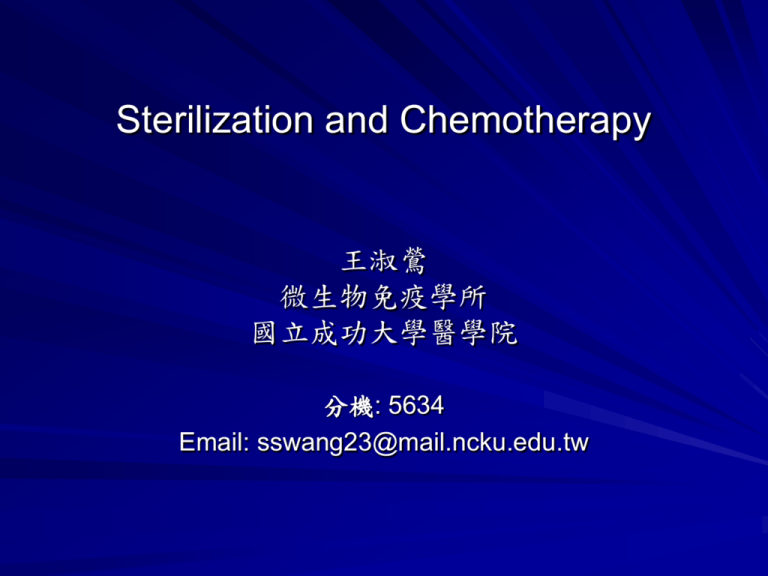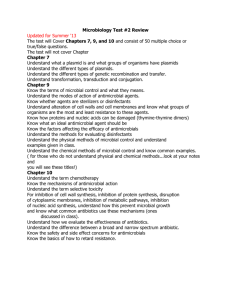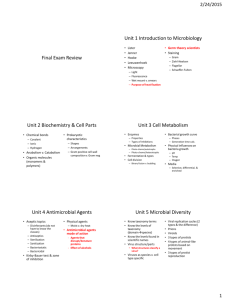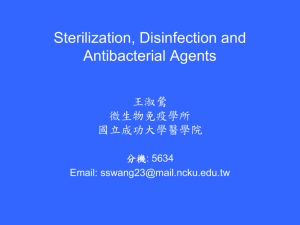Sterilization, Disinfection and Antibacterial Agents
advertisement

Sterilization and Chemotherapy 王淑鶯 微生物免疫學所 國立成功大學醫學院 分機: 5634 Email: sswang23@mail.ncku.edu.tw Outline Definition of Sterilization and Disinfection Physical and Chemical Methods of Antimicrobial Control Antibiotics and Mechanisms of Antimicrobial Action References: Chapters 8 & 20 in Medical Microbiology (Murray, P. R. et al; 6th edition) Early civilizations practiced salting, smoking, pickling, drying, and exposure of food and clothing to sunlight to control microbial growth. Use of spices in cooking was to mask taste of spoiled food. Some spices prevented spoilage. In mid 1800s Semmelweiss and Lister helped developed aseptic techniques to prevent contamination of surgical wounds. Before then: • Nosocomial infections caused death in 10% of surgeries. • Up to 25% mothers delivering in hospitals died due to infection Antimicrobial Definitions Sterilization – To completely remove all kinds of microbes (bacteria, mycobacteria, viruses, & fungi) by physical or chemical methods – Effective to kill “bacterium spores” – Sterilant: material or method used to remove or kill all microbes Antimicrobial Definitions Disinfection – To reduce the number of pathogenic microorganisms to the point where they no longer cause diseases – Usually involves the removal of vegetative or non-endospore forming pathogens – May use physical or chemical methods Disinfectant: An agent applied to inanimate objects. Antiseptic: A substance applied to living tissue. Degerming: Removal of most microbes in a limited area. Example: Alcohol swab on skin. Sanitization: Use of chemical agent on food-handling equipment to meet public health standards and minimize chances of disease transmission. e.g.: Hot soap & water Antimicrobial Definitions Bacteriostatic – prevents growth of bacteria Germicide – An agent that kills certain microorganisms. Bactericide: An agent that kills bacteria. Most do not kill endospores. Viricide: An agent that inactivates viruses. Fungicide: An agent that kills fungi. Sporicide: An agent that kills bacterial endospores of fungal spores. Method of Control physical or chemical? – physical control includes heat, irradiation, filtration and mechanical removal – chemical control involves the use of antimicrobial chemicals – depends on the situation – degree of control required air filters antimicrobial chemicals Factors influence the effectiveness of antimicrobial treatment Number of Microbes: The more microbes present, the more time it takes to eliminate population. Type of Microbes: Endospores are very difficult to destroy. Vegetative pathogens vary widely in susceptibility to different methods of microbial control. Environmental influences: Presence of organic material (blood, feces, saliva, pH etc.) tends to inhibit antimicrobials. Time of Exposure: Chemical antimicrobials and radiation treatments are more effective at longer times. In heat treatments, longer exposure compensates for lower temperatures. Rate of Microbial Death When bacterial populations are heated or treated antimicrobial chemicals, they usually die at a constant rate. Physical Methods of Microbial Control heat filtration radiation Physical Methods of Microbial Control Heat – Kills microorganisms by denaturing their enzymes and other proteins. Heat resistance varies widely among microbes. – fast, reliable, inexpensive – does not introduce potential toxic substances types of heat control include – moist heat – pasteurization – dry heat Physical Methods of Microbial Control Moist Heat: Kills microorganisms by coagulating their proteins. Boiling: Heat to 100oC or more at sea level. Kills vegetative forms of bacterial pathogens. Most pathogens can be killed within 10 minutes or less. Endospores and some viruses are not destroyed this quickly. In general, moist heat is much more effective than dry heat. Physical Methods of Microbial Control Moist Heat (Continued): Reliable sterilization with moist heat requires temperatures above that of boiling water. Autoclave: Chamber which is filled with hot steam under pressure. Preferred method of sterilization, unless material is damaged by heat, moisture, or high pressure. Temperature of steam reaches 121oC at twice atmospheric pressure. All organisms and endospores are killed within 15 minutes. Autoclave: Closed Chamber with High Temperature and Pressure Physical Methods of Microbial Control Moist Heat (Continued): Pasteurization: Developed by Louis Pasteur to prevent the spoilage of beverages. Used to reduce microbes responsible for spoilage of beer, milk, wine, juices, etc. Classic Method of Pasteurization: Milk was exposed to 65oC for 30 minutes. High Temperature Short Time Pasteurization (HTST): Used today. Milk is exposed to 72oC for 15 seconds. Physical Methods of Microbial Control Dry Heat: Direct Flaming: Used to sterilize inoculating loops and needles. Heat metal until it has a red glow. Incineration: Effective way to sterilize disposable items (paper cups, dressings) and biological waste. Hot Air Sterilization: Place objects in an oven. Require 2 hours at 170oC for sterilization. Dry heat is transfers heat less effectively to a cool body, than moist heat. Physical Methods of Microbial Control Filtration: Removal of microbes by passage of a liquid or gas through a screen like material with small pores. Used to sterilize heat sensitive materials like vaccines, enzymes, antibiotics, and some culture media. Membrane Filters: Uniform pore size. Used in industry and research. Different sizes: 0.22 and 0.45um Pores: Used to filter most bacteria. Don’t retain spirochetes, mycoplasmas and viruses. 0.01 um Pores: Retain all viruses and some large proteins. High Efficiency Particulate Air Filters (HEPA): Used in operating rooms to remove bacteria from air. Physical Methods of Microbial Control Filtration used for heat sensitive fluids air Physical Methods of Microbial Control Low Temperature: Effect depends on microbe and treatment applied. Refrigeration: Temperatures from 0 to 7oC. Bacteriostatic effect. Reduces metabolic rate of most microbes so they cannot reproduce or produce toxins. Freezing: Temperatures below 0oC. Physical Methods of Microbial Control Desiccation: In the absence of water, microbes cannot grow or reproduce, but some may remain viable for years. After water becomes available, they start growing again. Susceptibility to desiccation varies widely: Neisseria gonnorrhea: Only survives about one hour. Mycobacterium tuberculosis: May survive several months. Viruses are fairly resistant to desiccation. Clostridium spp. and Bacillus spp.: May survive decades. Physical Methods of Microbial Control Osmotic Pressure: The use of high concentrations of salts and sugars in foods is used to increase the osmotic pressure and create a hypertonic environment. Plasmolysis: As water leaves the cell, plasma membrane shrinks away from cell wall. Yeasts and molds: More resistant to high osmotic pressures. Staphylococci spp. that live on skin are fairly resistant to high osmotic pressure. Physical Methods of Microbial Control Radiation: Three types of radiation kill microbes: 1. Ionizing Radiation: Gamma rays, X rays, electron beams, or higher energy rays. Have short wavelengths (less than 1 nanometer). Used to sterilize pharmaceuticals, disposable medical supplies and food. Disadvantages: Penetrates human tissues. May cause genetic mutations in humans. Forms of Radiation Physical Methods of Microbial Control Radiation: Three types of radiation kill microbes: 2. Ultraviolet light (Nonionizing Radiation): Wavelength is longer than 1 nanometer. Damages DNA by producing thymine dimers, which cause mutations. Used to disinfect operating rooms, nurseries, cafeterias. Disadvantages: Damages skin, eyes. Doesn’t penetrate paper, glass, and cloth. Physical Methods of Microbial Control Radiation: Three types of radiation kill microbes: 3. Microwave Radiation: Wavelength ranges from 1 millimeter to 1 meter. Heat is absorbed by water molecules. May kill vegetative cells in moist foods. Bacterial endospores, which do not contain water, are not damaged by microwave radiation. Solid foods are unevenly penetrated by microwaves. Chemical Methods of Microbial Control Types of Disinfectants 1. Phenols and Phenolics: Phenol (carbolic acid) was first used by Lister as a disinfectant. Rarely used today because it is a skin irritant and has strong odor. Phenolics are chemical derivatives of phenol Cresols (Lysol): Derived from coal tar. Biphenols: Effective against gram-positive staphylococci and streptococci. Excessive use in infants may cause neurological damage. Destroy plasma membranes and denature proteins. Advantages: Stable, persist for long times after applied, and remain active in the presence of organic compounds. Chemical Methods of Microbial Control Types of Disinfectants 2. Halogens: Effective alone or in compounds. A. Iodine: Iodine tincture (alcohol solution) was one of first antiseptics used. B. Chlorine: When mixed in water forms hypochlorous acid: Cl2 + H2O ------> H+ + Cl- + HOCl Hypochlorous acid Used to disinfect drinking water, pools, and sewage. Chemical Methods of Microbial Control Types of Disinfectants 3. Alcohols: Kill bacteria, fungi, but not endospores or naked viruses. Act by denaturing proteins and disrupting cell membranes. Used to mechanically wipe microbes off skin before injections or blood drawing. Not good for open wounds, because cause proteins to coagulate. Ethanol: Drinking alcohol. Optimum concentration is 70%. Isopropanol: Rubbing alcohol. Better disinfectant than ethanol. Also cheaper and less volatile. Chemical Methods of Microbial Control Types of Disinfectants 4. Heavy Metals: Include copper, selenium, mercury, silver, and zinc. Very tiny amounts are effective. A. Silver: 1% silver nitrate used to protect infants against gonorrheal eye infections, now has been replaced by erythromycin. B. Mercury Organic mercury compounds like merthiolate and mercurochrome are used to disinfect skin wounds. C. Copper Copper sulfate is used to kill algae in pools and fish tanks. Chemical Methods of Microbial Control Types of Disinfectants 5. Quaternary Ammonium Compounds (Quats): Cationic (positively charge) detergents. Effective against gram positive bacteria, less effective against gram-negative bacteria. Chemical Methods of Microbial Control Types of Disinfectants 6. Aldehydes: Include some of the most effective antimicrobials. Inactivate proteins by forming covalent crosslinks with several functional groups. A. Formaldehyde: Excellent disinfectant, 2% aqueous solution. Commonly used as formalin, a 37% aqueous solution. Formalin was used extensively to preserve biological specimens and inactivate viruses and bacteria in vaccines. Irritates mucous membranes, strong odor. Chemical Methods of Microbial Control Types of Disinfectants 6. Aldehydes: B. Glutaraldehyde: Less irritating and more effective than formaldehyde. Commonly used to disinfect hospital instruments. 7. Gaseous Sterilizers: Chemicals that sterilize in a chamber similar to an autoclave. Denature proteins, by replacing functional groups with alkyl groups. Ethylene Oxide: Kills all microbes and endospores, but requires exposure of 4 to 18 hours. Chemical Methods of Microbial Control Types of Disinfectants 8. Oxidizing Agents: Oxidize cellular components of treated microbes. Disrupt membranes and proteins. A. Ozone: Used along with chlorine to disinfect water. Helps neutralize unpleasant tastes and odors. More effective killing agent than chlorine, but less stable and more expensive. Highly reactive form of oxygen. Made by exposing oxygen to electricity or UV light B. Hydrogen Peroxide: Not good for open wounds because quickly broken down by catalase present in human cells. Effective in disinfection of inanimate objects Outline Definition of Sterilization and Disinfection Physical and Chemical Methods of antimicrobial control Antibiotics and Mechanisms of Antimicrobial Action Definition of an Antibiotic Substance produced by a microorganism or a similar product produced wholly (synthetic) or partially (semisynthetic) by chemical synthesis and in low concentrations inhibits the growth of or kills microorganisms. Microbial Sources of Antibiotics Antibiotic Spectrum of Activity No antibiotic is effective against all microbes Mechanisms of Antimicrobial Action Bacteria have their own enzymes for – Cell wall formation – Protein synthesis – DNA replication – RNA synthesis – Synthesis of essential metabolites Modes of Antimicrobial Action Antibacterial Antibiotics Inhibitors of Cell Wall Synthesis Bacteria cell wall contains peptidoglycan Antimicrobials that interfere with the synthesis of cell wall do not interfere with eukaryotic cell Antimicrobials of this class include β- lactam drugs Vancomycin Daptomycin Bacitracin Antibacterial Antibiotics Inhibitors of Cell Wall Synthesis Penicillins and Cephalosporins – Part of group of drugs called β – lactams Have shared chemical structure called β-lactam ring – Competitively inhibits function of penicillin-binding proteins (involved in the final stages of the synthesis of peptidoglycan) Inhibits peptide bridge formation between glycan molecules This causes the cell wall to develop weak points at the growth sites and become fragile. Antibacterial Antibiotics Inhibitors of Cell Wall Synthesis The weakness in the cell wall causes the cell to lyze. Antibacterial Antibiotics Inhibitors of Cell Wall Synthesis Natural penicillins Narrow range of action Susceptible to penicillinase (b- lactamase) Semisynthetic Penicillins – Penicilinase-resistant penicillins Carbapenems: very broad spectrum Monobactam: Gram negative – Extended-spectrum penicillins Antibacterial Antibiotics Inhibitors of Cell Wall Synthesis Cephalosporins – chemical structures make them resistant to inactivation by certain β-lactamases – most effective against Gram – bacteria. – chemically modified to produce family of related compounds 2nd, 3rd, and 4th generations more effective against gram-negatives (4th generation against almost Enterobacteriaceae and Pseudomonas aeruginosa) Antibacterial Antibiotics Inhibitors of Cell Wall Synthesis Bacitracin – Interferes with transport of peptidoglycan precursors across cytoplasmic membrane – Toxicity limits use to topical applications – Common ingredient in non-prescription first-aid ointments Antibacterial Antibiotics Inhibitors of Cell Wall Synthesis Vancomycin – Inhibits formation of glycan chains – Important in treating infections caused by penicillin resistant Gram + organisms – Acquired resistance most often due to alterations in side chain of NAM molecule Prevents binding of vancomycin to NAM component of glycan – Important "last line" against antibiotic resistant S. aureus Antibacterial Antibiotics Inhibitors of Protein Synthesis Inhibition of protein synthesis – Structure of prokaryotic ribosome acts as target for many antimicrobials of this class Differences in prokaryotic and eukaryotic ribosomes responsible for selective toxicity – Drugs of this class include Aminoglycosides Tetracyclins Macrolids Chloramphenicol Antibacterial Antibiotics Inhibitors of Protein Synthesis Aminoglycosides – binds to ribosomal subunits – Examples of aminoglycosides include Gentamicin, streptomycin and neomycin – Often used in synergistic combination with β-lactam drugs Allows aminoglycosides to enter cells that are often resistant – Side effects Nephrotoxicity Antibacterial Antibiotics Inhibitors of Protein Synthesis Tetracyclins – Reversibly bind 30S ribosomal subunit Blocks attachment of tRNA to ribosome – Effective against certain Gram + and Gram – – Can cause discoloration of teeth if taken as young child Antibacterial Antibiotics Inhibitors of Protein Synthesis Macrolids – Reversibly binds to 50S ribosome Prevents continuation of protein synthesis – Effective against variety of Gram + organisms and those responsible for atypical pneumonia – Often drug of choice for patients allergic to penicillin – Macrolids include Erythromycin, clarithromycin and azithromycin Antibacterial Antibiotics Inhibitors of Protein Synthesis Chloramphenicol – Binds to 50S ribosomal subunit Prevents peptide bonds from forming and blocking proteins synthesis – Effective against a wide variety of organisms – Generally used as drug of last resort for life-threatening infections – Rare but lethal side effect is aplastic anemia (because it disrupts protein synthesis in human bone marrow cells) Antibacterial Antibiotics Inhibitors of Nucleic Acid Synthesis Fluoroquinolones – Inhibit action of topoisomerase DNA gyrase – Examples include Ciprofloxacin and ofloxacin – Urinary tract infections Rifamycins – Block prokaryotic RNA polymerase – Primarily used to treat tuberculosis and preventing meningitis after exposure to N. meningitidis Antibacterial Antibiotics Inhibitors of Metabolic Pathway Sulfonamides (sulfa drugs) – Inhibit folic acid synthesis – Structurally similar to para-aminobenzoic acid Substrate in folic acid pathway Through competitive inhibition of enzyme that aids in production of folic acid – Inhibit growth of Gram + and Gram - organisms Antibacterial Antibiotics Disruption of Plasma Membrane Polymyxin B – Binds membrane of Gram - cells Alters permeability – Leads to leakage of cell and cell death Also bind eukaryotic cells but to lesser extent – Limits use to topical application – Common ingredient in first-aid skin ointments Mechanisms of Antibiotic Resistance Enzymatic destruction of drug – Some organisms produce enzymes that chemically modify drug Penicillinase breaks βlactam ring of penicillin antibiotics Alteration of drug's target site – Minor structural changes in antibiotic target can prevent binding Changes in ribosomal RNA prevent macrolids from binding to ribosomal subunits Mechanisms of Antibiotic Resistance Prevention of penetration of drug – Alterations in porin proteins decrease permeability of cells Prevents certain drugs from entering Rapid ejection of the drug – Some organisms produce efflux pumps Increases overall capacity of organism to eliminate drug – Enables organism to resist higher concentrations of drug – Tetracycline resistance EFFECTS OF COMBINATIONS OF DRUGS Synergism – the chemotherapeutic effects of two drugs given simultaneously is greater than the effect of either given alone – For example, penicillin and streptomycin in the treatment of bacterial endocarditis. Damage to bacterial cell walls by penicillin makes it easier for streptomycin to enter EFFECTS OF COMBINATIONS OF DRUGS Antagonism – the chemotherapeutic effects of two drugs given simultaneously reduce the effect of either given alone – For example, the simultaneous use of penicillin and tetracycline is often less effective than when wither drugs is used alone. By stopping the growth of the bacteria, the bacteriostatic drug tetracycline interferes with the action of penicillin, which requires bacterial growth.







